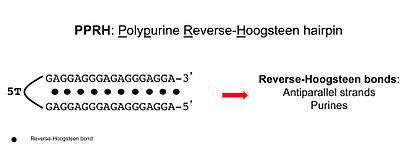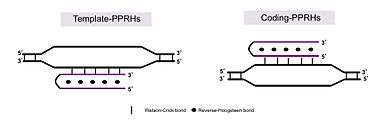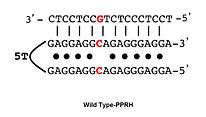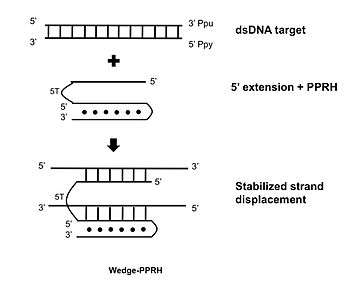Polypurine reverse-Hoogsteen hairpin
Polypurine reverse-Hoogsteen hairpins (PPRHs) are non-modified oligonucleotides containing two polypurine domains, in a mirror repeat fashion, linked by a pentathymidine stretch forming double-stranded DNA stem-loop molecules. The two polypurine domains interact by intramolecular reverse-Hoogsteen bonds allowing the formation of this specific hairpin structure.

Properties

PPRHs can bind to polypyrimidine stretches in either single- or double stranded DNA by Watson and Crick bonds establishing triple-stranded DNA structures. The formation of PPRHs triplexes takes place at physiological pH. PPRHs provoke a strand displacement.[1] of the homopurine sequence of the target dsDNA, opening the two strands of the DNA. There are two types of PPRHs: i) Template-PPRHs[2] that bind to the template strand of DNA, inhibiting transcription; and ii) Coding-PPRHs[3] that bind to the coding strand of the DNA altering splicing. Both types of PPRHs decrease gene expression. PPRHs present high stability in serum and cells and show lack of immunogenicity not activating the innate inflammatory response.[4] PPRHs do not have off-target effects and do not show hepatotoxicity or nephrotoxicity.[5]
Applications
PPRHs could be used as gene silencing tools[6] acting by different mechanisms than triplex forming oligonucleotides (TFOs), antisense oligonucleotides or siRNAs. Upon binding to their targets, PPRHs can decrease the mRNA and protein levels of the selected genes. Their action has been demonstrated in vitro for a number of genes involved in metabolism (DHFR), proliferation (mTOR), DNA topology (TOP1), lifespan and senescence (telomerase), apoptosis (survivin, BCL2), transcription factors (MYC), proto-oncogenes (MDM2)[7], and replication stress (WEE1, CHK1)[8] as part of a cancer gene therapy strategy. Their preclinical proof of principle has been proven in vivo using the antiapoptotic survivin gene.[9] PPRHs have also been applied as tools in cancer immunotherapy by silencing CD47 in MCF7 breast cancer cells and SIRPα in macrophages,[10] and the PD-1/PD-L1 pathway in human tumor cells.[11][12]
Design and improvements

PPRHs can be designed for virtually any gene in the genome by searching for polypirimidine stretches in the sequence of the desired gene. Optimal lengths for each domain of the PPRHs are within 20–30 nucleotides. The total length of a typical PPRH is 55 nucleotides considering two domains of 25 bases plus 5T for the linking loop. If purine interruptions are encountered (up to three) within the polypirimidine target, the highest affinity of PPRH binding is achieved by placing in the hairpin the complementary base (a pyrimidine) in front of the purines[13] (Wild type-PPRH).
Wedge-PPRH
A further development consists in extending the 5' flank of the PPRH with a sequence complementary to the displaced polypurine strand of the target dsDNA which stabilizes the strand displacement, producing additional binding and functionality.[13]

WEB tools for mapping and analysis of triplex formation target DNA sequences in the human genome
A triplex target DNA site (TTS), a stretch of DNA that is composed of polypurines, is able to form a triple-helix (triplex) structure in genomic DNA. Integrative WEB tools for identification and analysis of the triplex formation target DNA sequences, including PPRH sequences, associated with genes and regulatory elements (e.g., transcription factor binding sites, repeats, G-quadruplet motifs, SNPs, and non-protein coding regulatory DNA elements) in the human genome are publicly available (see External links). [14][15]
These tools could be used to search biologically meaningful genome polypurine stretches, help to understand biological roles of the natural paired polypurine domains like PPRH and to optimize experimental design of anti-gene treatment.
References
- Coma, Silvia; Noe, Veronique; Eritja, Ramon; Ciudad, Carlos (2005). "Strand Displacement of Double-Stranded DNA by Triplex-Forming Antiparallel Purine-Hairpins" (PDF). Oligonucleotides. 15 (4): 269–83. doi:10.1089/oli.2005.15.269. hdl:10261/124878. PMID 16396621.
- de Almagro, Cristina; Coma, Silvia; Noe, Veronique; Ciudad, Carlos (2009). "Polypurine Hairpins Directed against the Template Strand of DNA Knock Down the Expression of Mammalian Genes". The Journal of Biological Chemistry. 284 (17): 11579–89. doi:10.1074/jbc.M900981200. PMC 2670163. PMID 19261618.
- de Almagro, Cristina; Mencia, Nuria; Noe, Veronique; Ciudad, Carlos (2011). "Coding Polypurine Hairpins Cause Target-Induced Cell Death in Breast Cancer Cells". Human Gene Therapy. 22 (4): 451–63. doi:10.1089/hum.2010.102. PMID 20942657.
- Villalobos, Xenia; Rodriguez, Laura; Prevot, Jeanne; Oleaga, Carlota; Ciudad, Carlos; Noe, Veronique (2013). "Stability and Immunogenicity Properties of the Gene-Silencing Polypurine Reverse Hoogsteen Hairpins". Molecular Pharmaceutics. 11 (1): 254–64. doi:10.1021/mp400431f. PMID 24251728.
- Félix, Alex J.; Ciudad, Carlos J.; Noé, Véronique (September 2018). "Functional pharmacogenomics and toxicity of PolyPurine Reverse Hoogsteen hairpins directed against survivin in human cells". Biochemical Pharmacology. 155: 8–20. doi:10.1016/j.bcp.2018.06.020. ISSN 1873-2968. PMID 29940174.
- Aviñó, Anna; Eritja, Ramon; Ciudad, Carlos J.; Noé, Verónica (2019). "Parallel Clamps and Polypurine Hairpins (PPRH) for Gene Silencing and Triplex‐Affinity Capture: Design, Synthesis, and Use". Current Protocols in Nucleic Acid Chemistry. 77 (1): e78. doi:10.1002/cpnc.78. hdl:10261/182909. ISSN 1934-9270. PMID 30912630.
- Villalobos, Xenia; Rodriguez, Laura; Sole, Anna; Liberos, Carolina; Mencia, Nuria; Ciudad, Carlos; Noe, Veronique (2015). "Effect of Polypurine Reverse Hoogsteen Hairpins on Relevant Cancer Target Genes in Different Human Cell Lines". Nucleic Acid Therapeutics. 25 (4): 198–208. doi:10.1089/nat.2015.0531. PMID 26042602.
- Aubets, Eva; Noé, Véronique; Ciudad, Carlos J. (2020). "Targeting replication stress response using polypurine reverse hoogsteen hairpins directed against WEE1 and CHK1 genes in human cancer cells". Biochemical Pharmacology. 175: 113911. doi:10.1016/j.bcp.2020.113911. PMID 32173365.
- Rodriguez, Laura; Villalobos, Xenia; Dakhel, Sheila; Padilla, Laura; Hervas, Rosa; Hernandez, Jose Luis; Ciudad, Carlos; Noe, Veronique (2013). "Polypurine reverse Hoogsteen hairpins as a gene therapy tool against survivin in human prostate cancer PC3 cells in vitro and in vivo". Biochemical Pharmacology. 86 (11): 1541–54. doi:10.1016/j.bcp.2013.09.013. PMID 24070653.
- Bener, Gizem; J Félix, Alex; Sánchez de Diego, Cristina; Pascual Fabregat, Isabel; Ciudad, Carlos J.; Noé, Véronique (2016-09-26). "Silencing of CD47 and SIRPα by Polypurine reverse Hoogsteen hairpins to promote MCF-7 breast cancer cells death by PMA-differentiated THP-1 cells". BMC Immunology. 17 (1): 32. doi:10.1186/s12865-016-0170-z. ISSN 1471-2172. PMC 5037635. PMID 27671753.
- Medina Enríquez, Miriam Marlene; Félix, Alex J.; Ciudad, Carlos J.; Noé, Véronique (2018). "Cancer immunotherapy using PolyPurine Reverse Hoogsteen hairpins targeting the PD-1/PD-L1 pathway in human tumor cells". PLOS ONE. 13 (11): e0206818. Bibcode:2018PLoSO..1306818M. doi:10.1371/journal.pone.0206818. ISSN 1932-6203. PMC 6219785. PMID 30399174.
- Ciudad, Carlos J; Medina Enriquez, Mariam Marlene; Félix, Alex J; Bener, Gizem; Noé, Véronique (2019). "Silencing PD-1 and PD-L1: the potential of PolyPurine Reverse Hoogsteen hairpins for the elimination of tumor cells". Immunotherapy. 11 (5): 369–372. doi:10.2217/imt-2018-0215. ISSN 1750-743X. PMID 30786843.
- Rodríguez, Laura; Villalobos, Xenia; Solé, Anna; Lliberós, Carolina; Ciudad, Carlos J.; Noé, Véronique (2015). "Improved Design of PPRHS for Gene Silencing". Molecular Pharmaceutics. 12 (3): 867–877. doi:10.1021/mp5007008. PMID 25615267.
- Jenjaroenpun, P; Kuznetsov, VA (2009). "TTS mapping: integrative WEB tool for analysis of triplex formation target DNA sequences, G-quadruplets and non-protein coding regulatory DNA elements in the human genome". BMC Genomics. 10 Suppl3 (S9): S9. doi:10.1186/1471-2164-10-S3-S9. PMC 2788396. PMID 19958507.
- Jenjaroenpun, P; Chew, CS; Yong, TP; Choowongkomon, K; Kuznetsov, VA (2015). "The TTSMI database: a catalog of triplex target DNA sites associated with genes and regulatory elements in the human genome". Nucleic Acids Res. 43(Database issue) (D110-6): D110–D116. doi:10.1093/nar/gku970. PMC 4384029. PMID 25324314.
External links
- Triplex-Forming Oligonucleotide Target Sequence Search Tool: A Searching Tool to find Polypurine and Polypyrimidine stretches in DNA
- http://ttsmi.bii.a-star.edu.sg/: The TTSMI database: a catalog of triplex target DNA sites associated with genes and regulatory elements in the human genome. Jenjaroenpun P, Chew CS, Yong TP, Choowongkomon K, Thammasorn W, Kuznetsov VA.
- http://ggeda.bii.a-star.edu.sg/~piroonj/TTS_mapping/TTS_mapping.php:TTS mapping: integrative WEB tool for analysis of triplex formation target DNA sequences, G-quadruplets and non-protein coding regulatory DNA elements in the human genome. Jenjaroenpun P, Kuznetsov VA.